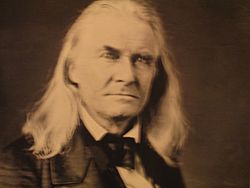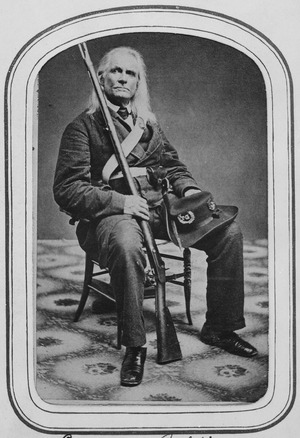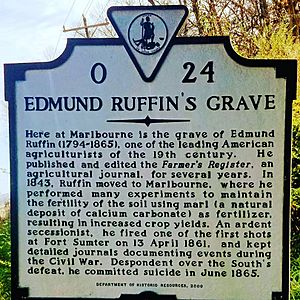Edmund Ruffin facts for kids
Quick facts for kids
Edmund Ruffin III
|
|
|---|---|

A photograph of Edmund Ruffin, displayed at Fort Sumter National Monument in Charleston, South Carolina
|
|
| Member of the Virginia Senate | |
| In office 1823–1827 |
|
| Personal details | |
| Born | January 5, 1794 Prince George County, Virginia, U.S. |
| Died | June 18, 1865 (aged 71) Redmoor, Amelia County, Virginia, U.S. |
| Resting place | Edmund Ruffin Plantation |
| Spouse | Susan Hutchings Travis |
| Children | 11 |
| Education | College of William and Mary |
| Occupation | Planter, agronomist, author, soldier |
| Known for | Revolutionizing Southern agriculture; his claim to have fired the first shot of the Civil War |
Edmund Ruffin III (born January 5, 1794 – died June 18, 1865) was a wealthy farmer from Virginia. He served in the Virginia Senate from 1823 to 1827. In the years leading up to the American Civil War, his writings supporting slavery became more famous than his work in farming. Ruffin owned enslaved people and strongly believed in states' rights and slavery. He pushed for Southern states to leave the United States years before the Civil War began.
Ruffin is also known for his important work in improving soil. He found new ways to make soil healthy and productive. He suggested using crop rotation and adding certain materials to help soil that was worn out from growing too much tobacco. Early in his career, he studied swamps to learn how to fix soil that was too acidic. He published his ideas in essays and a book. Because of his work, he is sometimes called "the father of soil science" in the United States.
Contents
Edmund Ruffin: Planter, Scientist, and Civil War Figure
Early Life and Family
Edmund Ruffin was born on January 5, 1794, at Evergreen Plantation in Prince George County, Virginia. He came from a rich family of farmers in Virginia and inherited large areas of land. His grandfather, also named Edmund Ruffin, was a politician during the American Revolutionary War. Edmund Ruffin III received a private education and later attended the College of William and Mary in Williamsburg, Virginia.
In 1813, Ruffin married Susan Hutchings Travis. They moved to a plantation called Coggin's Point. They had eleven children together before Susan died in 1846. Many of their children passed away before the Civil War ended.
A Pioneer in Soil Science
Like many other large farmers in Virginia, Ruffin used enslaved labor on his plantations. He owned several properties, including Coggins Point and Shellbanks. Records show he owned many enslaved people, with the number growing over the years.
When he was in his twenties, Ruffin started experimenting with his land. The soil was tired from growing tobacco for over a century. Tobacco uses up many nutrients from the soil. Ruffin discovered that adding a type of marl (a mix of clay, silt, and lime) could make the soil healthy again.
In 1835, Ruffin moved from his plantation to the city of Petersburg. He left the daily management of his farms and the supervision of enslaved people to others. In 1843, he bought another plantation called Marlbourne in Hanover County, Virginia. The soil there was also worn out from tobacco farming. Ruffin became a serious agronomist, which is a scientist who studies soil and crops. He became a leader in promoting ways to protect and renew soil.
Ruffin was part of a group of thinkers who wanted to improve Southern life. He edited writings by William Byrd II and published his own ideas. For a time in the 1840s, he was the editor of the Farmers Register magazine. He studied how to use lime to reduce soil acidity. His important book, An Essay on Calcareous Manures (1852), explained how adding marl helped his worn-out land grow better crops like corn and wheat. These works earned him the title "father of soil science" in the United States.
Ruffin also studied swamps in Virginia, like the Great Dismal Swamp. Some people today believe his contributions to agriculture are more important than his claim of firing the first shot of the Civil War. However, his advice on using marl was not widely followed during his own time.
His Role in the Road to Civil War
Ruffin strongly supported slavery and what he called the Southern way of life. He became very vocal as tensions grew between the North and South in the 1850s. Some people called him a Fire Eater because he openly supported states leaving the Union and fighting to defend the South.
In 1859, Ruffin traveled to witness the execution of John Brown in Charles Town, Virginia (now West Virginia). John Brown was an abolitionist who had tried to start a slave revolt at Harper's Ferry. To get close to the event, Ruffin joined the Virginia Military Institute cadets. He later collected several pikes that Brown's forces had planned to use to arm enslaved people. Ruffin sent these pikes to the governors of slave-holding states to show what he saw as Northern hostility against the South.
In 1860, Ruffin published a book called Anticipations of the Future. In it, he predicted an American civil war in 1868 that would end with the Southern states winning. While many of his predictions were wrong, he did correctly guess that the war would begin with a Southern attack on Fort Sumter in South Carolina.
The Civil War and His Final Days
After Abraham Lincoln was elected president in 1860, Ruffin traveled to South Carolina to encourage states to leave the Union. He felt very happy there. Ruffin is famous for supposedly firing one of the first shots from Morris Island against the Union-held Fort Sumter on April 12, 1861. This event is generally seen as the start of the Civil War. Ruffin was also the first person to enter Fort Sumter after Southern forces took it over.
During the Civil War, Union forces took over and looted several of Ruffin's plantations. His plantation at Coggins Point was the site of the Beefsteak Raid during the Siege of Petersburg. As the war continued, Ruffin moved to different family homes to stay safe from the fighting.
Legacy
When the Civil War ended with the Confederate defeat, Ruffin was devastated. He had already lost his wife and eight of his eleven children. Feeling hopeless after the surrender of Robert E. Lee in 1865, Ruffin took his own life.
His body was buried at Marlbourne, his plantation in Hanover County, Virginia.
Both Evergreen (Hopewell, Virginia), where Ruffin was born, and the Edmund Ruffin Plantation (Marlbourne) still exist today. They are recognized as important historical sites. Edmund Ruffin is often called the "father of soil science" in the United States, and his writings have been very important for understanding how to protect soil.



